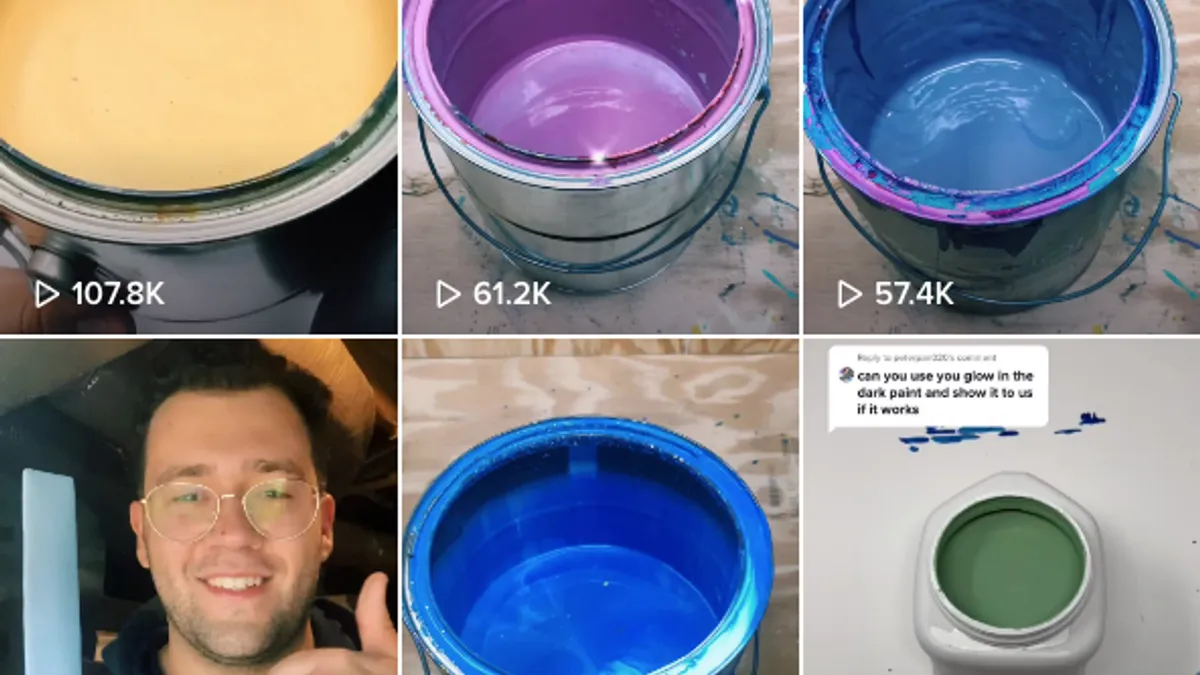UPDATE: Nov. 25, 2020: After being fired from Sherwin-Williams, Tony Piloseno has been hired full-time by rival Florida-based paint marketer Florida Paints, which will supply the viral TikTok creator with materials to use in videos and work with him on developing a line of custom products, Ad Age reported. Piloseno, who is joining Florida Paint's sales and operations division, claimed he received offers from Sherwin-Williams rivals like Behr, Benjamin Moore and PPG, but opted to go with the smaller business to get away "from the corporate culture of things," per Ad Age.
Dive Brief:
-
Sherwin-Williams faced a barrage of criticism on Twitter days after BuzzFeed News reported that the maker of paints and coatings had fired a college student whose paint-mixing videos went viral on social video app TikTok.
-
The controversy started after Tony Piloseno, a senior at Ohio University who had worked part-time at a local Sherwin-Williams store, shared a video with his 1.4 million TikTok followers that explained how the company had fired him last summer for a variety of workplace offenses. The report by BuzzFeed News triggered an outpouring of sympathy for Piloseno and scorn for Sherwin-Williams.
-
Twitter users said Sherwin-Williams had wasted a significant marketing opportunity, and accused the brand of being out of touch with younger audiences, PR Week reported. "If someone can make viral videos about paint, he should be celebrated and given a senior marketing role. Instead @SherwinWilliams fires the guy," Casey Neistat, a YouTube star with 2 million followers on Twitter, said in a tweet that captured much of the negative sentiment toward Sherwin-Williams.
Dive Insight:
The negative reactions toward Sherwin-Williams show how a story can quickly propagate on social media, testing the ability of brands to respond and quickly take command of the public narrative. Piloseno has generated sympathy with his side of the story, which explains that he had started making videos showing how to mix paint on his @tonerserpaints channel on TikTok, and had started to amass a following. He claims that he had pointed out his viral videos to Sherwin-Williams management as an example of how the company could reach a younger audience on the social video app, BuzzFeed News reported.
Instead, Sherwin-Williams fired Piloseno on the grounds of "gross misconduct" that included "wasting properties [and] facilities," and "seriously embarrass[ing] the company or its products," BuzzFeed News reported. After its story appeared, a Sherwin-Williams spokesperson said the company had received a customer complaint about Piloseno's videos. Piloseno said he had made TikTok videos while on the job to demonstrate the process of paint-mixing, but later bought his own paint with his employee discount to make videos. As the videos grew more popular, he created a pitch deck to show how the company could boost its social media presence, but management dismissed his ideas, he said. A key cause of consternation was a TikTok video in which Piloseno experimented with mixing blueberries in white paint, leading customers to call Sherwin-Williams to ask about it, BuzzFeed News reported.
While the facts presented in BuzzFeed News' story indicate that Sherwin-Williams had legal grounds to fire Piloseno for alleged violations of company policy, the company missed an opportunity to leverage the popularity of his viral videos into developing an organic following on social media. Amid the negative publicity, Sherwin-Williams runs the risk of being perceived as a backward-looking, uninspiring and humorless brand that's out of touch with Generation Z consumers who in the next decade will become the biggest demographic group in the U.S.
Alternatively, Sherwin-Williams could have embraced the positive publicity that social media can generate for brands as consumers highlight products in videos shared with friends and followers — a tactic recently utilized by other brands. Most notably, cranberry grower Ocean Spray turned a viral TikTok video made by an unknown Idaho resident into a campaign that generated good will toward its brand. Previously, Chipotle Mexican Grill found inspiration from an employee who posted a viral video on TikTok showing how to flip its food containers, turning the trend into a branded hashtag challenge that generated hundreds of millions of views for the burrito chain. These efforts all demonstrated a willingness to be nimble in harnessing viral trends and memes to remain relevant among younger consumers who spend more time on social media.












